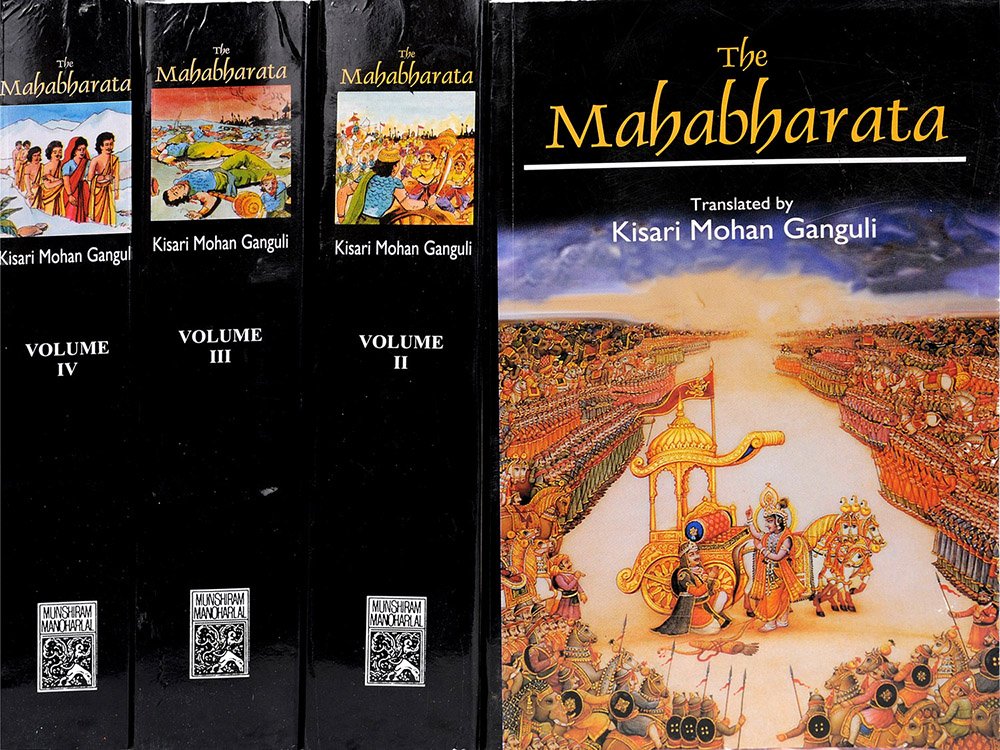Mahabharata (English)
by Kisari Mohan Ganguli | 2,566,952 words | ISBN-10: 8121505933
The English translation of the Mahabharata is a large text describing ancient India. It is authored by Krishna-Dwaipayana Vyasa and contains the records of ancient humans. Also, it documents the fate of the Kauravas and the Pandavas family. Another part of the large contents, deal with many philosophical dialogues such as the goals of life. Book...
Section C
"Narada continued,
'Here is that spacious and celebrated city of cities, called Hiranyapura, belonging to the Daityas and Danavas, possessing a hundred diverse kinds of illusion. Here in these regions called Patala, it has been built with great care by the divine artificer, and planned by the Danava Maya. Endued with great energy and heroism, many Danavas, having obtained boons (from Brahman) in days of old, lived here, exhibiting a thousand different kinds of illusion. They were incapable of being vanquished by Sakra or any other celestial, that is, by either Yama, or Varuna, or the Lord of treasures (Kuvera).
Here dwell, O Matali, those Asuras called Kalakhanjas who sprang from Vishnu, and those Rakshasas also called Yatudhanas who sprang from the feet of Brahman. All of them are endued with frightful teeth, terrible impetus, the speed and prowess of the wind, and great energy depending on powers of illusion. Besides these, another class of Danavas called Nivatakavacas, who are invincible in battle, have their abode here. You knowest bow Sakra is unable to vanquish them. Many times, O Matali, you, with your son Gomukha, and the chief of the celestials and lord of Sachi, along with his son, had to retreat before them.
Behold their homes, O Matali, that are all made of silver and gold, and well-adorned with decorations done according to the rules of art. All those mansions are decked with lapis lazuli and corals, and made effulgent with the lustre of the Arkasphatika, and the radiance of gem called Vajrasara. And many of those palatial residences seem, as if, they have been made of the shine of these gems called Padmaragas, or of bright marble, or of excellent wood. And they are also possessed of the radiance of the sun, or blazing fire. And all the edifices, adorned with gems and jewels, are very high and stand close to another. Of spacious proportions and great architectural beauty, it is impossible to say of what material these mansions are built or to describe their style of beauty. Indeed, they are exceedingly beautiful in consequence of their decorations.
Behold these retreats of the Daityas for recreation and sport, these beds of theirs for sleep, these costly utensils of theirs set with precious stones, and these seats also for their use.
Behold these hills of theirs, looking like clouds, those fountains of water, these trees also that move of their own will and that yield all fruits and flowers that one may ask. See, O Matali, if any bridegroom may be had here, acceptable to you. If no one can be found, we shalt, if you likest, go hence to some other part of the world.' Thus addressed, Matali answered Narada, saying, 'O celestial Rishi, it behoves me not to do anything that may be disagreeable to dwellers of heaven.
The gods and the Danavas, though brothers, are ever at hostility with each other. How can I, therefore, make an alliance with those that are our enemies? Let us repair, therefore, to some other place. It behoves me not to search among the Danavas. As regards thyself, I know your heart is ever set on fomenting quarrels.'"
Conclusion:
This concludes Section C of Book 5 (Udyoga Parva) of the Mahabharata, of which an English translation is presented on this page. This book is famous as one of the Itihasa, similair in content to the eighteen Puranas. Book 5 is one of the eighteen books comprising roughly 100,000 Sanskrit metrical verses.
FAQ (frequently asked questions):
Which keywords occur in Section C of Book 5 of the Mahabharata?
The most relevant definitions are: Danava, Matali, Danavas, Sakra, Brahman, Narada; since these occur the most in Book 5, Section C. There are a total of 24 unique keywords found in this section mentioned 41 times.
What is the name of the Parva containing Section C of Book 5?
Section C is part of the Bhagavat-Yana Parva which itself is a sub-section of Book 5 (Udyoga Parva). The Bhagavat-Yana Parva contains a total of 89 sections while Book 5 contains a total of 4 such Parvas.
Can I buy a print edition of Section C as contained in Book 5?
Yes! The print edition of the Mahabharata contains the English translation of Section C of Book 5 and can be bought on the main page. The author is Kisari Mohan Ganguli and the latest edition (including Section C) is from 2012.
